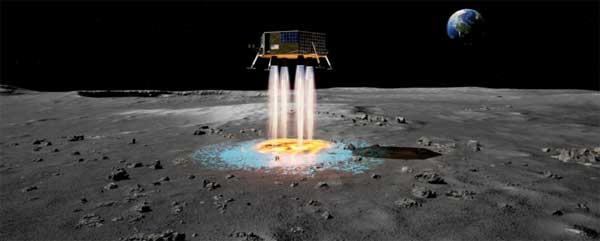
MOJAVE, Calif. — A new court document reveals that an unidentified company nearly purchased now-bankrupt Masten Space Systems earlier this year, but it ultimately backed away due to financial concerns about Masten Mission 1 (MM1), the company’s program to deliver a small rover and a suite of instruments to the south pole of the moon under a NASA contract.
“On April 29, Company A informed Masten that it did not plan to proceed with a deal because of the substantial liabilities recognized to date and additional future projected losses associated with MM1,” an Aug. 10 filing in Delaware Bankruptcy Court said.
The declaration, signed by Founder and CTO Dave Masten, said the company subsequently had discussions with two other potential suitors, identified as Company B and Company C, but nothing resulted from the efforts. The company’s effort to raise $60 million from investors required to carry out MM1 for NASA also failed.
In late July, the company sought protection from its creditors by filing for Chapter 11 bankruptcy. The move came after the company, which is seeking to reorganize and resume operations, laid off 22 workers and furloughed all but six employees.
In April 2020, NASA awarded a $75.9 million contract to the company to deliver the MoonRanger and a suite of scientific instruments to the lunar south pole and operate them for at least 12 days. The space agency made the award under its Commercial Lunar Payload Service (CLPS) initiative, under which it paid companies to deliver payloads to the moon.
At the time, the award appeared to be a massive boost to the small company, which built and tested a series of vertical takeoff and landing vehicles and performed research and development projects (R&D) at the wind-swept Mojave Air and Space Port in California. Instead, it helped to drive the company to bankruptcy.
NASA’s contract didn’t cover the full amount of the mission. Masten also had to pay for the launch of the mission aboard a SpaceX Falcon 9. A source who requested anonymity told Parabolic Arc that Masten had greatly underbid the project, which an internal estimate put at $105 million. The company would have to make up the gap by raising money from investors or finding other parties to fly payloads MM1.
The declaration filed this week said the company suffered delays and cost overruns as a result of the supply chain delays caused by the COVID-19 pandemic, design changes required for its XL-1 lander, and inexperience with managing such a large project.
“Historically, Masten has also eschewed a formal managerial hierarchy. Rather than an organizational chart, Masten implement a ‘function chart’ in 2020, which identified various subject areas and the individual(s) within the company who were primarily and secondarily responsible for those subject areas. Masten did not hire its first experienced project manager until May 2021,” the document said.
“MM1 entailed expenses far greater than any previous Masten Mission. Masten struggled to manage these expenses, at least partly because it lacked experienced project managers, did not have a sophisticated approach to managing expenses or program planning, and was struggling to rapidly scale its workforce and facilities in the midst of a historic pandemic,” the declaration added.
As a result, Masten found it would be unable to land MM1 at the lunar south pole in December 2022 as scheduled. In February, NASA adjusted the contract to shift the landing to no later than January 2024. The contract award was also raised by $5.4 million to $81.3 million.
Masten’s declaration said the company’s effort to raise $60 million at the end of 2021 turned out to be a case of little too late.
Masten’s timing was particularly poor because it kicked off its efforts between the Thanksgiving and Christmas holidays,” the document said. “Masten’s fundraising efforts also came on the heels of a special purpose acquisition company (‘SPAC’) trend in the space industry. Between April and December 2021, nine space companies went public through SPAC mergers. Private investment in space companies broke records in 2021, but many investors interested in making substantial investments in space companies had already done so by the time Masten entered the market late in the year.”
A SPAC is a “blank check” company that is already traded on a stock exchange. A SPAC’s only purpose is to find a company with which to merge and take public under that company’s name. Both of Richard Branson’s space companies, Virgin Galactic and Virgin Orbit, went public through SPACs.
Masten also experience problems defining itself.
“Masten’s fundraising efforts were also hindered by messaging issues,” the declaration stated. “Masten was difficult to categorize: it was not a startup in the conventional sense, as it had existed for over seventeen years and sustained itself on the revenue it generated, but it was not yet an established company. Moreover, Masten’s business did not have a clear or strategic focus; it generated the majority of its revenue (but also the bulk of its costs) from MM1, but it also conducted suborbital VTVL and test operations and was engaged in numerous R&D projects.”
Masten did attract interest from a number of potential investors, but nothing came of the efforts. Attempts to be acquired by the three unidentified companies would prove similarly unsuccessful.
In January 2022, the Masten Board of Directors instructed CEO Sean Mahoney step away from day-to-day operations of the company. Executive Chairman Joel Scotkin, who owns 51.67% of the company, stepped in to run the company and lead fund-raising efforts. Mahoney would leave the company in April.

